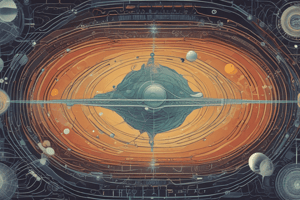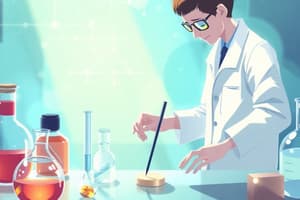Podcast
Questions and Answers
The first step of the scientific method involves formulating a hypothesis based on initial observations.
The first step of the scientific method involves formulating a hypothesis based on initial observations.
False (B)
In a well-designed experiment, changing multiple variables simultaneously is crucial for obtaining comprehensive results.
In a well-designed experiment, changing multiple variables simultaneously is crucial for obtaining comprehensive results.
False (B)
A hypothesis is a confirmed explanation of a phenomenon, backed by extensive experimental evidence, and widely accepted in the scientific community.
A hypothesis is a confirmed explanation of a phenomenon, backed by extensive experimental evidence, and widely accepted in the scientific community.
False (B)
The dependent variable is intentionally manipulated by the scientist to observe its effect on another variable.
The dependent variable is intentionally manipulated by the scientist to observe its effect on another variable.
In the scientific method, the primary goal of an experiment is to prove a hypothesis correct.
In the scientific method, the primary goal of an experiment is to prove a hypothesis correct.
Maintaining constants in an experiment ensures that any observed changes are due to the manipulation of the dependent variable.
Maintaining constants in an experiment ensures that any observed changes are due to the manipulation of the dependent variable.
Collecting data is a crucial step in the scientific method that follows the formulation of a question.
Collecting data is a crucial step in the scientific method that follows the formulation of a question.
Sharing results, whether they support or contradict the initial hypothesis, is an essential component of the scientific method.
Sharing results, whether they support or contradict the initial hypothesis, is an essential component of the scientific method.
Interpreting data always involves modifying the data to align with the original hypothesis when discrepancies arise.
Interpreting data always involves modifying the data to align with the original hypothesis when discrepancies arise.
Controlled variables, also known as constants, are factors that are changed during an experiment to observe their impact on the outcome.
Controlled variables, also known as constants, are factors that are changed during an experiment to observe their impact on the outcome.
In an experiment, controlled attributes are intentionally altered to observe their effect on the outcome.
In an experiment, controlled attributes are intentionally altered to observe their effect on the outcome.
A timeline displays events exclusively in chronological order, using consistent time increments such as days, months, or years.
A timeline displays events exclusively in chronological order, using consistent time increments such as days, months, or years.
The engineering design process concludes after creating the first prototype.
The engineering design process concludes after creating the first prototype.
Electrons are solely responsible for creating an electrical current; protons and neutrons do not contribute.
Electrons are solely responsible for creating an electrical current; protons and neutrons do not contribute.
Valence electrons are located in the innermost electron shell of an atom and determine its chemical properties.
Valence electrons are located in the innermost electron shell of an atom and determine its chemical properties.
Atoms can be broken down into smaller units through basic chemical reactions.
Atoms can be broken down into smaller units through basic chemical reactions.
A molecule consisting of two hydrogen atoms ($H_2$) is classified as a compound.
A molecule consisting of two hydrogen atoms ($H_2$) is classified as a compound.
All compounds are classified as either ionic or covalent based on the type of bonds between their molecules.
All compounds are classified as either ionic or covalent based on the type of bonds between their molecules.
Pure substances may contain several types of compounds and/or elements which do not form chemical bonds with each other.
Pure substances may contain several types of compounds and/or elements which do not form chemical bonds with each other.
The periodic table organizes elements alphabetically based on their names.
The periodic table organizes elements alphabetically based on their names.
Flashcards
Scientific Method
Scientific Method
A series of steps to ensure scientific work is done correctly.
Research
Research
Learning everything about the question at hand.
Hypothesis
Hypothesis
A prediction about what you think will happen.
Independent Variable
Independent Variable
Signup and view all the flashcards
Dependent Variable
Dependent Variable
Signup and view all the flashcards
Constants
Constants
Signup and view all the flashcards
Experiment
Experiment
Signup and view all the flashcards
Results
Results
Signup and view all the flashcards
Conclusion
Conclusion
Signup and view all the flashcards
Scientific Evidence
Scientific Evidence
Signup and view all the flashcards
Controlled Variables
Controlled Variables
Signup and view all the flashcards
Engineering Design Process
Engineering Design Process
Signup and view all the flashcards
Atom
Atom
Signup and view all the flashcards
Valence Electrons
Valence Electrons
Signup and view all the flashcards
Molecule
Molecule
Signup and view all the flashcards
Compound
Compound
Signup and view all the flashcards
Element
Element
Signup and view all the flashcards
Periodic Table
Periodic Table
Signup and view all the flashcards
Ionic Bond
Ionic Bond
Signup and view all the flashcards
Covalent Bond
Covalent Bond
Signup and view all the flashcards
Study Notes
Scientific Method
- A series of steps scientists use to ensure accurate work.
- Steps include: asking a question, research, making a prediction, experimentation (gathering evidence), collecting results, sharing results or revising prediction.
Experiment Design
- Experiments follow the scientific method.
- Key components include:
- A clear question
- Hypothesis (statement of expected outcome based on prior knowledge)
- Constants (factors kept the same)
- Independent variable (factor changed)
- Dependent variable (factor measured)
- Conclusion (states if hypothesis was supported)
Data Interpretation
- Scientific evidence is all collected data.
- To interpret data, check if it answers the question and supports the hypothesis.
- Data interpretation explains what the data shows.
Types of Variables
- Variables are features in experiments that can change.
- Three types:
- Independent variable: changed by the scientist
- Dependent variable: measured/observed outcome
- Controlled variable: kept the same throughout the experiment.
Timelines
- Timelines show events in order.
- Understanding the topic and time units (days, months, years, decades, centuries) is key for interpreting timelines.
Engineering Design Process
- A series of steps for problem-solving by engineers.
- Steps include:
- Ask (define the problem)
- Research
- Imagine (brainstorm solutions)
- Select & Plan (choose a solution, plan how to build)
- Create (build a prototype)
- Test & Evaluate (test and refine)
- Improve (revise and create a final product).
Atoms
- Atoms are the smallest building blocks of matter.
- Atoms have a nucleus (protons and neutrons) with electrons orbiting around it.
- Atoms bond to form different substances (solid, liquid, gas).
Electrons
- Electrons are negatively charged particles orbiting the nucleus.
- Electrons can create electrical current and bond atoms.
- Not all materials' atoms have the same number of electrons.
Valence Electrons
- Valence electrons are electrons in the outermost electron shell.
- Valence electrons are important for determining element combinations.
- The periodic table helps determine valence electrons based on group.
Molecules
- Molecules are two or more bonded atoms.
- The number and type of atoms determine a molecule’s size and shape.
Elements, Compounds, Mixtures
- Elements: Single type of atom, cannot be broken down.
- Compound: Two or more different types of elements chemically bonded.
- Mixture: Two or more compounds/elements without chemical bonding.
- Pure Substances: Contain only one type of compound or element.
Periodic Table
- The periodic table organizes all known elements.
- Provides information like element name, symbol, atomic number, and mass.
- Helps identify an element as metal, nonmetal, or metalloid.
Elements Properties
- Elements include solids, liquids, and gases.
- Each element has a unique name, symbol, and atomic number (number of protons).
- Common elements (H, He, C, O, N, Na, Au, Ag, Fe, Cu, Al, Cl, Si) are highlighted.
- Elements are fundamental building blocks of matter.
Studying That Suits You
Use AI to generate personalized quizzes and flashcards to suit your learning preferences.
Description
Briefly learn about the scientific method, experiment design, data interpretation, and types of variables. The scientific method includes a series of steps scientists use to ensure accurate work. Key components of experiment design include a clear question, hypothesis, constants, independent variable, dependent variable, and conclusion.




